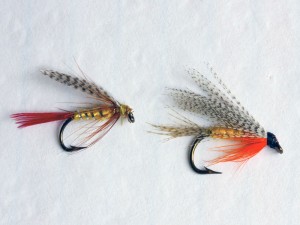One of the strengths of America is that we are never satisfied. A national mania for innovation is what drives our economic success. Collectively, Americans look at something and seem to say “I can do it better”. This “madness” extends to fly fishing in many ways. What was wrong with bamboo rods, canvas waders and a baloney sandwich on stream? Do we really need gourmet meals, white tablecloths and chilled wine ?
One of the aspects of fly tying is the drive to innovate and invent “new” flies for whatever reason. I have a book, written by Don DuBois in 1960, which lists 5,939 trout fly patterns. Many are variations on a theme using natural materials. I’m sure that number has doubled since then because of synthetic materials. People who name flies after themselves are another facet of the madness. Will it ever end? Is all this necessary? Probably yes. Like Labradoodles, though, is it really what we need? If you can’t avoid it, just sit back and enjoy it.
The Professor wet fly is a classic 150-year old pattern named after a Scottish professor represents various trout foods from mayflies to small smolts in the river depending on the size. For me, it has worked very well in moving water especially with a down and across presentation. One particular evening, the fly was taking fish but not as many as I expected. When one of the fish coughed up some little smolts, the light bulb went off. Salmon and Steelhead fry were common in the river this time of year so maybe some adjustments could be made to the fly and it might become more effective. Since no mayflies were emerging I felt that I was on the right track. That evening I pawed through the tying materials and came up with the variation below.
Professor and Naughty Professor
Hook: Mustad 3906 or 3906B nymph hook (10-16) Tiemco 9300 or 3761
Thread: Black or yellow 6/0
Tail: Red hackle fibers——- mallard flank fibers for Naughty Professor
Rib: Fine gold tinsel or wire——- pearl mylar for Naughty Professor
Body: Yellow floss——-half yellow silk shank back half orange silk shank for Naughty Professor
Hackle: Ginger hen or brown partridge——-orange throat for Naughty Professor
Wing: Gray Mallard flank feather (rolled)——-rolled mallard flank for Naughty Professor
Although you can’t see it too well in the photo, in the water the yellow and orange threads on the shank look more like a smolt yolk sac and the orange like red gills.
The slightly larger gape and incremental longer length on the 3906B aids in hooking and mimicked the taper of a smolt better. The translucent wet silk and pearl mylar also looked more like a clear smolt body. The end result was a more effective fly in this situation. Over the next few days, the newer pattern seemed to work better than the original. The “naughty” name came from a comment about the flashy, trashy look of the fly. I just didn’t have the courage to name it after myself.
Sit back and enjoy the madness.
La Pêche est ma Folie



